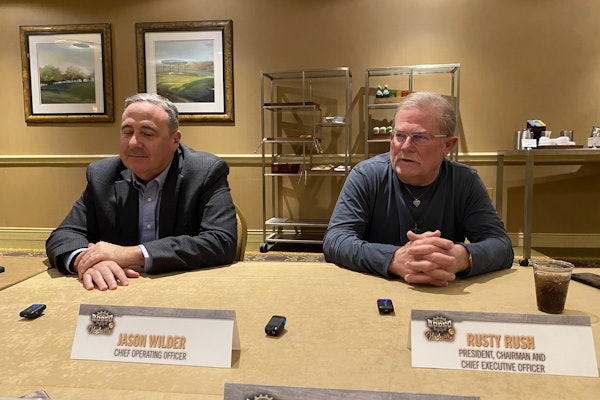By Bill Wade, Wade & Partners
Bruce Merrifield and I have been following Amazon’s (AMZN) escalating threats to legacy business-to-business channels for several years. The boys in Seattle have been creating ways to take more sales from distributors and retailers of physical products so quickly and broadly … tracking this forward march could be a full-time job!
Amazon Is Inventing a Disruptively-Different Channel
In the heavy-duty truck parts business, legacy B2B channels were created by manufacturers to push products to end-users. So strong was the supplier control in the 1950s and early 1960s that factories actually designated territories and markets in which distributors could operate. Associations like NWRA and AEA were probably defying certain clauses of antitrust laws.
Amazon started instead with the end-user — their computer screens and their doorsteps — and then built a customer-centric infrastructure back to factories worldwide. This channel has new capabilities and value that will steal varying amounts of sales, but especially on the most profitable commodity SKU rebuys from heavy-duty dealers and distributors.
AMZN Has Created Over Nine Additional Reinforcing Platforms
Amazon has created other platforms to support their re-channeling efforts. These platforms scale digitally and robotically and continually improve due to countless customer-centric experiments by teams of Amazon associates. You should understand these consistently reassessed and improved supports:
- Prime members. The best loyalty program ever, which has millennial B2B buyers addicted.
- Best performing website. Period.
- Marketplace with two million resellers and more than 450 million SKUs.
- Crowdsourced, radical product information available 24/7.
- Amazon Web Services (AWS).
- Fulfillment by Amazon (FBA) (Most trusted brand).
- Last-mile logistics.
- Alexa/Echo/Dot/Dash that will dominate voice commerce by 2020.
- AMZN Global Supply Chain (Emerging)
- Incipient platforms, including multimedia video production for reseller content; bonus points for watching educational product videos; and AMZN banking/loyalty points programs.
In addition, these platforms will be turbocharged in major markets by 2020 with 5G bandwidth.
Here’s What You Need to Do
Heavy-duty distributors have three years to get a cost-to-serve model to know and reduce the net profit/loss cross-subsidies that exist among their customers, SKUs, territories and types of orders. Otherwise, customers will split orders, spot-buy the most profitable items for less at Amazon and still give the small-dollar (losing) picks to distributors.
Distributors also need to become (really) customer-centric, and fast. They need to tune service metrics and levels to profitability, size, and niche segment needs. Then heavy-duty specialists must provide and sell the supply chain math solutions that the biggest and best customers want.
So far, ‘Product Service’ seems to be an area that Amazon has yet to pierce. Our historical feeling that ‘nobody knows (product, your truck, specific vocations, newest accessories)’ just hasn’t proven to be true.
When expert systems begin to predict component failure, this claim of information superiority starts to look like the ‘Legend of John Henry.” Look it up, millennials.
OOPS. This just in … three corporate giants (Amazon, Berkshire Hathaway and JPMorgan Chase) are forming a company that could disrupt U.S. health care channels, providers and payment/economics. What did I just say about Amazon limitations when it comes to service?
Other ideas include: Amazon is testing a service that helps more third-party sellers get their merchandise listed with a Prime tag on Amazon.com. Called “FBA Onsite,” the service is designed to improve the number of items eligible for Amazon’s Prime shipping guarantee.
OOPS, again. This just in … Berkshire Hathaway reveals eSupply division. The Berkshire eSupply division created by Berkshire Hathaway after it purchased Production Tool Supply will provide maintenance, repair, operations and production inventory along with cloud-based e-commerce, vending and marketing services
Customers Are Targeting Long-Tail Costs
Amazon Business funded a study with Spend Matters (magazine). They announced conclusions on Dec. 20, 2017, that included:
- Procurement pros increasingly want to reduce long-tail spending costs.
- The big-spend items have been automated and integrated.
- But, pesky, bottom 35 percent of items: eat only 1 percent of the spend dollars; take over 50 percent of purchasing’s time; and are a pain for all to easily get.
Corporate citizens want Amazon’s business-to-consumer shopping experience on the job. But, purchasing wants controls. So, Amazon Business continues to invent cloud tools for purchasing control and analytics and wins sales.
Distributors: One-Up Amazon with right analytics, feet and imagination.
Amazon does not have (at least yet) people or robots visiting customer sites, nor does Amazon have the right, historical, statistical, SKU-spend data that you should have for your best customers.
Why not combine “feet,” “right analytics” and on-site creativity to reduce both long-tail activity costs and increase the uptime productivity for the SKUs’ users?
How Could It Work?
A distributor with a 10 percent operating profit subscribes to a Line-Item-Profit-Analytics cloud service (Waypointanalytics). They can rank all customers by the total number of line-item picks. Then, they pick ones with low-profit-dollar/pick averages that suggest too many small-dollar picks.
The solution? Visit these customers to investigate:
- How did their physical replenishment systems differ from other most profitable locations? Don’t forget the handling of cores.
- Take mental pictures of storage/inventory effectiveness techniques. Any best practices from best locations to share?
- Any stock-outs on the 40 big-losing, highly-reordered SKUs that caused downtime and small, emergency orders?
- See how to reduce 40 picks/SKU to one or two rebuys due to higher stock levels?
- Present the tradeoff math: higher inventory cost v, for example, 800 fewer rebuy-activity-cost events for both parties plus uptime benefits?
Now, act to invent a storage, reorder solution for them and share with any other locations. Document savings. Keep the account. Find and ask for more for share of spend. If Amazon is promoting Long-Tail needs, why not fill them first and better than Amazon using: right analytics, feet and imagination.
Bill Wade is a partner at Wade & Partners and a heavy-duty aftermarket veteran. He is the author of Aftermarket Innovations. He can be reached at [email protected].











